Fewer than 500 left: why saving Spoonie is a race against time
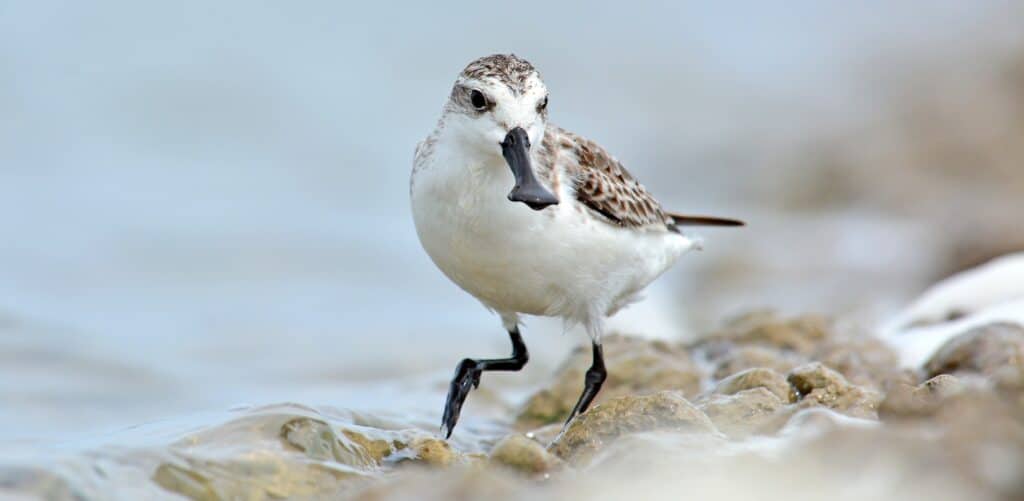
The world’s cutest wader – the unique, enigmatic Spoon-billed Sandpiper – is in severe trouble. A fleet of conservationists across Asia and beyond is striving to reverse its fortunes, but the battle is not yet won.
It is a nervy wait for fieldworkers painstakingly scanning Myanmar’s Gulf of Mottama – vast, sheeny, tidal mudflats equivalent to the area of Greater London. Has one of the world’s rarest, most charismatic waders safely returned to overwinter? Then, as the bird’s unmistakable form scurries into view, there comes an excited shout: “Spoon-billed Sandpiper!”
With its unique spatula-shaped bill, there is no shorebird remotely like Spoon-billed Sandpiper. Summer-plumaged adults are gorgeous, their flaming head and breast offset by strikingly white, black-spotted underparts. Accordingly, it has a place in the heart of any birdwatcher who has come across it, whether in life or through images. Which makes it all the more disconcerting that ‘Spoonie’ is considered Critically Endangered, with a population of fewer than 500 adult birds and continuing to decline, despite intensive conservation activity spanning Asia and beyond.
The Spoon-billed Sandpiper breeds exclusively in the wildest of places – a small area of north-east Russia, between the evocatively named peninsulas of Chukotka and Kamchatka. Come autumn, it wings along Asia’s Pacific coast, refuelling at traditional stopover sites in various countries, eventually migrating 8,000 kilometres to reach its winter haunts in Bangladesh, Thailand, Myanmar, Vietnam and south China.
This trajectory makes it unequivocally a denizen of the East Asian-Australasian Flyway, a migration superhighway followed by an astounding 50 million waterbirds that pause their journeys at 900 wetlands across 22 countries. The BirdLife International Partnership has long been steeped in the flyway’s conservation, a commitment now accelerated by the Asian Development Bank’s promise to invest $3 billion in 10 years to help protect 50 priority wetlands.
Dramatic decline
Spoon-billed Sandpiper certainly needs all the help it can get. This century has seen several attempts to quantify its rapidly withering population: all make for worrying reading. The most recent, published in 2021 from research led by Rhys Green of the RSPB (BirdLife in the UK) and Cambridge Conservation Initiative, suggests that just 773 birds remain (490 being breeding adults), and calculates an annual reduction of 9 per cent per year during 2009-2016.
Green’s calculations actually imply that the decline has slowed since the early 2000s, when Spoon-billed Sandpiper was losing half its population every two years – a terrifying rate that warranted its uplisting from Vulnerable to Endangered in 2004, then to Critically Endangered in 2008. In 2010, when a key paper charting the sandpiper’s decline was published, “it looked like we were staring extinction in the face,” says Christoph Zöckler, Co-ordinator of the East Asian-Australasian Flyway Partnership Spoon-billed Sandpiper Task Force, “and there would be no Spoon-billed Sandpipers left by the end of the decade.”
How did it ever come to this? The explanation is complex. One element is problems on the breeding grounds, whose remoteness confer no guarantee of safety. One in six breeding sites has suffered significant habitat degradation, while nests near villages can be destroyed by dogs. Furthermore, both bad weather and heavy predation (from foxes and jaegers) make it hard for adults to raise chicks. Hunting also exerts pressure: a survey in Kamchatka suggests that 6,000 small shorebirds – potentially including Spoonies – were killed in 2019. Climate change could be the biggest threat of all, Zöckler says, “squeezing the species out of options”. Modelling suggests that more than half the sandpiper’s breeding terrain could become unsuitable within 50 years.
By James Lowen
Header image: A Spoon-billed Sandpiper in its winter plumage © Butterfly Hunter/Shutterstock
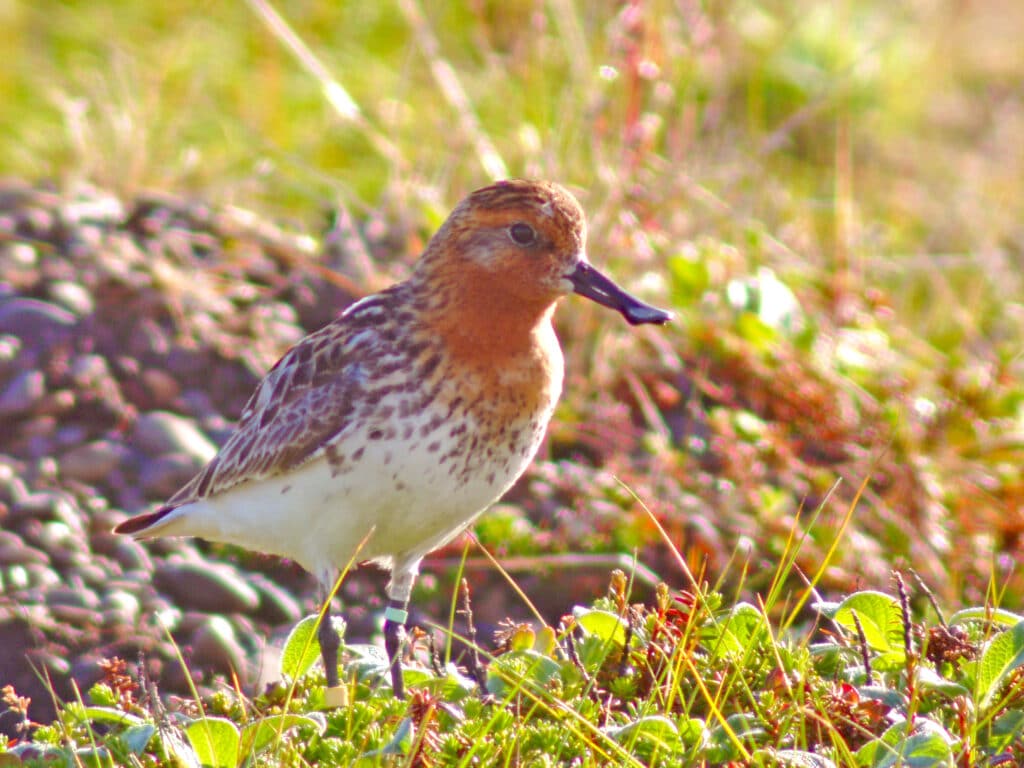
“It looked like we were staring extinction in the face, and there would be no Spoon-billed Sandpipers left by the end of the decade.”Christoph Zöckler, Co-ordinator of the East Asian-Australasian Flyway Partnership Spoon-billed Sandpiper Task Force
Dangerous Journey
This is surely trauma enough, but it is along its migratory route that Spoon-billed Sandpiper most keenly encounters problems. The severe population decline of the 2000s was driven by young birds dying on migration: the proportion of fledged birds that returned to nesting grounds was unsustainably low. Habitat loss and degradation have proved key issues, particularly the draining and reclamation of intertidal staging sites on the Yellow Sea. A single example speaks volumes. Hundreds of Spoonies used to gather at Saemangeum in the Republic of Korea. Since the world’s longest sea wall was built in the 2000s, reclaiming 400 square kilometres of mudflats, just one individual has been seen there. With fewer places to feed during their exhausting journey, Spoon-billed Sandpipers are literally flying themselves to death.
Ding Li Yong, BirdLife Regional Flyways Co-ordinator, thinks that trapping on passage and wintering grounds is “the greatest threat” to Spoonies. Most immature individuals apparently remain on non-breeding grounds for two years, rendering them particularly vulnerable to entanglement in nets set to catch large waders for food. A survey in Bangladesh revealed that eight of 53 hunters interviewed reckoned they had caught 22 Spoon-billed Sandpipers between them the previous winter.
Troubling though this finding is, it has an upside. “Saving any threatened bird relies on knowing what threats it faces and then being able to implement appropriate solutions,” the RSPB’s Guy Anderson says. Once conservationists learn of a threat to Spoonies, they can act on it. They have already joined forces through the Spoon-billed Sandpiper Task Force, which co-ordinates the implementation of the internationally agreed Species Action Plan. The Task Force, Christoph Zöckler says proudly, comprises “a team of like-minded people that work tirelessly for a common goal, conserving the species across the many cultural, religious and political borders along the flyway and beyond”.
Conservation activities range widely and impressively. Enforcement against illegal trapping has been stepped up. Outreach programmes have targeted the next generation – schoolchildren. In Bangladesh, China and Myanmar, hunters have been supported to switch to alternative activities. This works. Of 15 Gulf of Mottama hunters helped by BANCA (BirdLife in Myanmar), nine reported improved livelihoods and the other six no downturn. More than 80 per cent of hunters there have now agreed to cease hunting.

“Saving any threatened bird relies on knowing what threats it faces and then being able to implement appropriate solutions,”Guy Anderson, RSPB
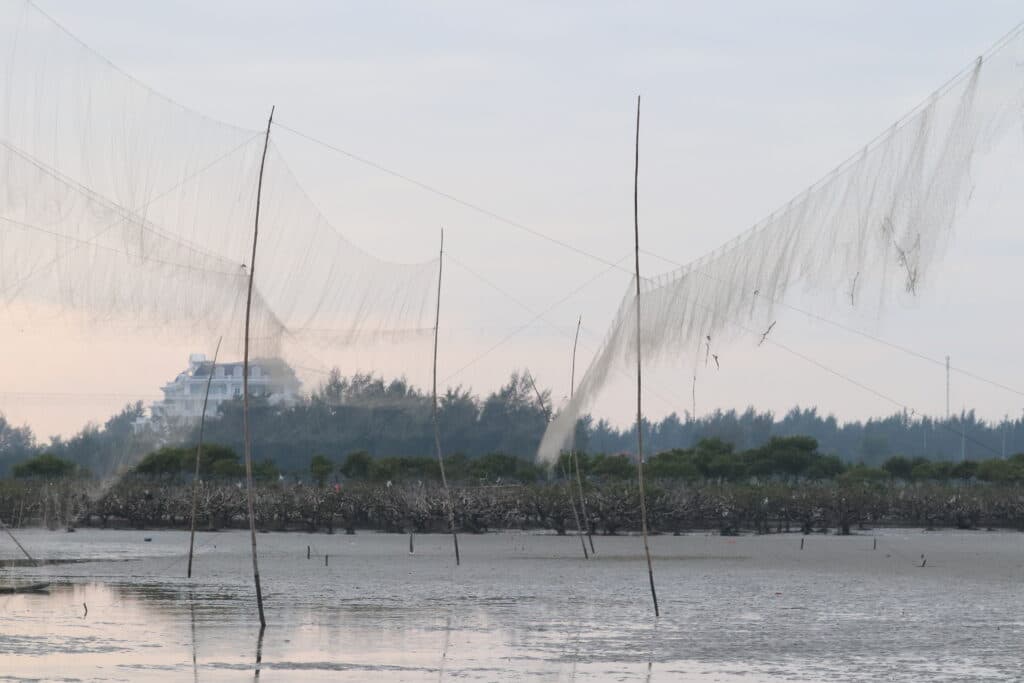
Helping Hand
In 2011, the Wildfowl and Wetlands Trust launched an ex-situ conservation breeding programme – the ultimate backstop. The captive population peaked at 25 birds (although sadly only seven remain), with successful breeding in 2019. Allied to this, since 2012 Birds Russia has counteracted nest failure by ‘headstarting’ around 200 young Spoonies. This involves moving eggs from nests into incubators, raising chicks in aviaries and, upon fledging, releasing them to migrate south. This approach is calculated to boost productivity five-fold, and should offer longer-term benefits: the first headstarted pair bred successfully in 2017.
Conservationists have also marked birds with numbered leg flags to track individuals throughout their lives. By 2019, such birds had been sighted 800 times across seven countries, offering insights into migration routes and wintering grounds. This understanding has been deepened by fitting 15 Spoonies with tiny satellite tags, which have revealed “an astonishing amount of critically important data about migration routes and timing, previously unknown stopover sites, fine detail on habitat selection and even responses to changes in environmental conditions,” Guy Anderson explains.
Gathering intelligence via technology and fieldwork is critical because “large gaps remain in our knowledge about the sandpiper’s distribution along the entire flyway,” says Graeme Buchanan of the RSPB. Indeed, the Task Force reckons that we still don’t know where three-quarters of Spoon-billed Sandpipers breed or where half of the birds winter. In Vietnam, for example, “they have received very little attention in recent years,” says Ding Li Yong. Fortunately, BirdLife, Viet Nature, Wild Tour and others are redressing the balance by “expanding survey effort to determine the country’s most important sites” for the species, as well as other migratory waterbirds including Black-faced Spoonbill (Endangered).
Once important locations are known, protection becomes conceivable. In 2019, the Bird Conservation Society of Thailand (BirdLife Partner) bought Pak Thale, the country’s most important shorebird site, to help Spoon-billed Sandpipers. In Myanmar’s eastern Gulf of Mottama, Ding Li Yong says: “BANCA is building capacity for monitoring through participatory approaches in local communities.” Assuming further funding, “BANCA will expand work into the western Gulf”.
Furthermore, in Vietnam, BirdLife and its counterparts will “work with local authorities to protect three wetlands where Spoon-billed Sandpipers have been discovered since 2019”.
Advocacy, meanwhile, is raising the profile of critically important Yellow Sea wetlands. In major successes, further land reclamation and habitat destruction has been halted in China, and the BirdLife Partnership has helped Republic of Korea authorities secure World Heritage Site status for vital tidal flats, including the Geum estuary, now Korea’s most important staging site for Spoon-billed Sandpiper. Endeavours to save the species, Christoph Zöckler judges, are “showcasing best practice in sustainable coastal zone management”.
“All this work throughout the flyway,” he explains, “has reduced the rate of Spoon-billed Sandpiper population decline from 26 per cent per year to 7-10 per cent”. He lauds this as a phenomenal achievement, but then cautions that it is not enough. This is because the latest exhaustive winter surveys impart deeply worrying news.
Spoon-billed Sandpiper numbers are dropping at many passage and wintering sites – in some places by more than 40 per cent in the last year. And after rising late last decade, the core breeding population at Meinypil’gyno in Russia has slumped to 2014 levels. “Overall, the news is not good,” Zöckler says. The population continues to decline, and he fears that “no more than 330-340 birds” may actually be left. “We will lose Spoonie if we do not redouble efforts to find the causes of the continuing decline and act immediately. We need a new plan of action.”
From headstarting on the Russian tundra to better protecting Vietnamese wetlands, from curbing illegal trapping in China to forging local partnerships on the Gulf of Mottama, one thing is clear: ‘Spoonie’ needs our help more than ever.
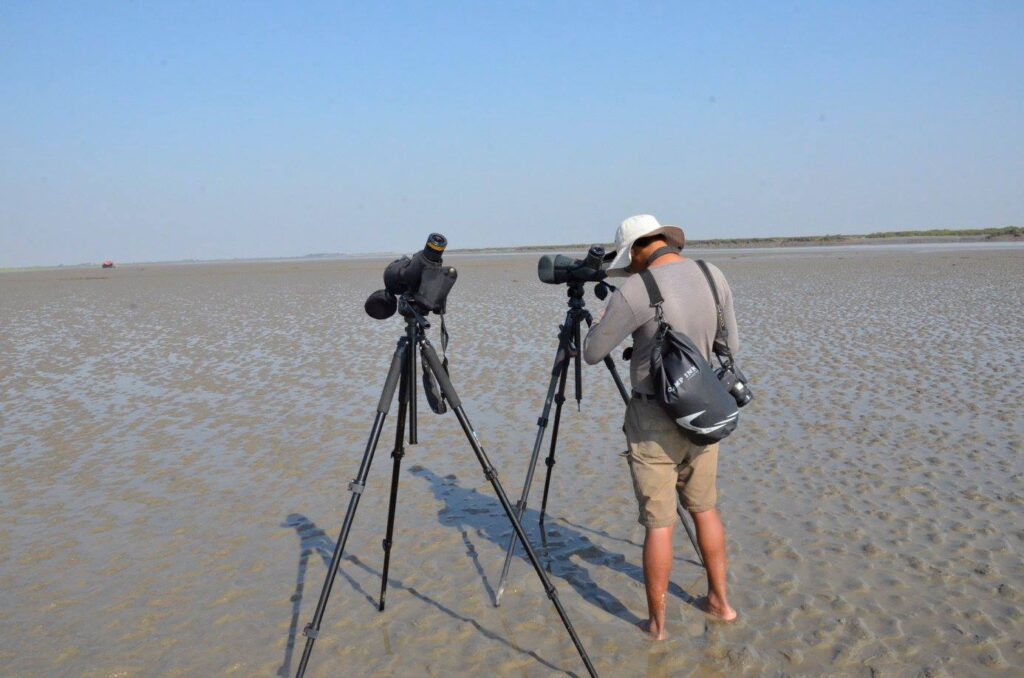
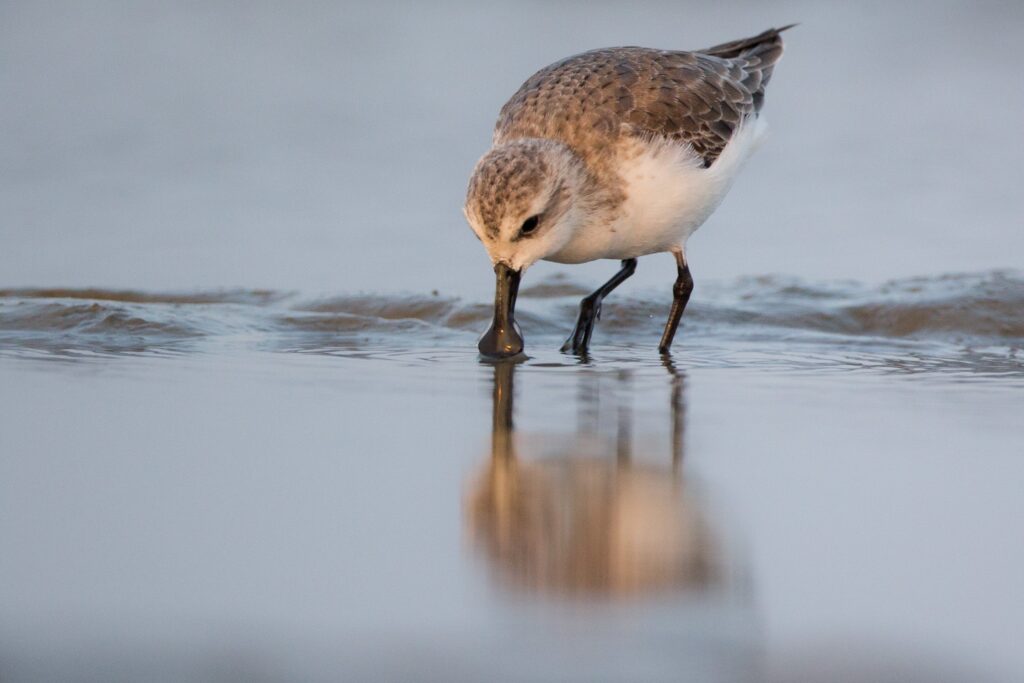
“We will lose Spoonie if we do not redouble efforts to find the causes of the continuing decline and act immediately. We need a new plan of action.”Christoph Zöckler, Co-ordinator of the East Asian-Australasian Flyway Partnership Spoon-billed Sandpiper Task Force
They are teetering on the edge of extinction, but you can help save Spoonie.
Also published in the BirdLife Magazine January-March 2022.